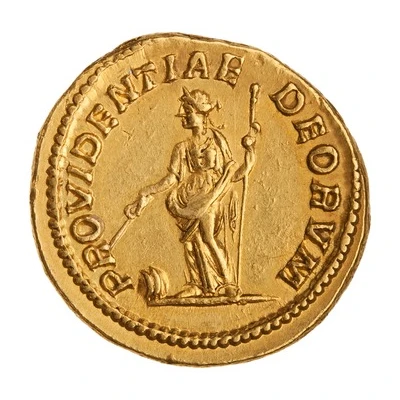Aureus - Caracalla SECVRITATI PERPETVAE; Securitas
| Gold | - | - |
| Issuer | Rome › Roman Empire (27 BC - 395 AD) |
|---|---|
| Emperor | Caracalla (Marcus Aurelius Antoninus Caracalla) (198-217) |
| Type | Standard circulation coin |
| Years | 213-217 |
| Value | 1 Aureus = 25 Denarii |
| Currency | Denarius, Reform of Augustus (27 BC – AD 215) |
| Composition | Gold |
| Shape | Round (irregular) |
| Technique | Hammered |
| Demonetized | Yes |
| Updated | 2024-10-05 |
| Numista | N#273533 |
|---|---|
| Rarity index | 100% |
Reverse
Securitas, draped, seated right on low seat, propping head on right hand and holding sceptre in left hand; before, altar.
Script: Latin
Lettering: SECVRITATI PERPETVAE
Translation:
Securitati Perpetuae.
To perpetual safety.
Comment
Source:Online Coins of the Roman Empire (OCRE)
Interesting fact
The Aureus - Caracalla coin was minted during the reign of Emperor Caracalla, who ruled the Roman Empire from 211 to 217 AD. The coin's obverse side features an image of Caracalla's portrait, while the reverse side depicts the goddess Securitas, who represents security and stability. The coin's inscription, "SECVRITATI PERPETVAE," translates to "Security for the Eternal," which reflects Caracalla's efforts to promote stability and security throughout the empire. This coin is made of gold, which was a valuable and highly sought-after metal during the Roman Empire. The Aureus - Caracalla coin was used as a means of exchange and was considered a symbol of wealth and power. Its value was equivalent to 25 silver denarii, which was a significant amount of money at the time. Overall, the Aureus - Caracalla coin is an interesting piece of history that provides insight into the economic, political, and cultural aspects of the Roman Empire during the 3rd century AD.

